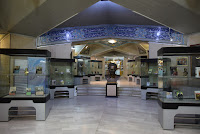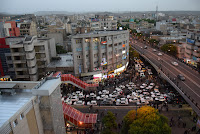Upon reaching Tabriz we drove around till we stopped close to the Maqbarat-o-Shoara Mausoleum, whose façade was partly covered by street panels all around. The garden where the mausoleum is located was filled with people sitting around talking or just taking advantage of the evening breeze.
I was drawn to particular statue proudly standing outside - that of a poet I would later identify as Mohammad-Hossein Shariar, a notable Iranian poet of Azerbaijani ethnicity, whose picture could be seen almost everywhere inside the Mausoleum. Known as the Mausoleum of poets Maqbarat-o-Shoara contains the graves of important poets, mystics, scientists and well-know people of Tabriz.
As I strolled around its magnificent interior I realised how ignorant I was in regards to Iranian poetry. I told myself then that I would definitely do something about it in the following months (potentially years).





Khaghani Shervani - He was considered the most important poet in the 6th century.
Qatran Tabrizi - A well known 5th century Azeri poet who wrote poems in Persian under the pen name pf Abu Mansour and the second poet to be buried in the Mausoleum.
Abu Nasr Ali Ibn Ahmad known as Asadi Toosi was the first poet to be buried in the Mausoleum.



I was able to look through some of the books on display at the Mausoleum library and to my astonishment came across several books written by our Nobel Prize in Literature awarded writer Saramago translated in Farsi.
The evening was emotionally intense and joyful as the results of the Iranian elections were revealed and Mr. Hassan Rouhani was re-elected the Head of Government. We were advised not stroll around streets located far from the hotel. Noelle, Didier and I managed to walk in and out of a few shops located just around the corner from the hotel and buy a few souvenirs (amongst which an embroidered coat I bought for myself).

















No comments:
Post a Comment